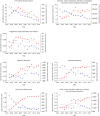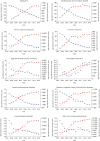1. World Health Organization. World Health Statistics. Geneva: World Health Organization;2009.
2. Stringhini S, Dugravot A, Shipley M, Goldberg M, Zins M, Kivimäki M, et al. Health behaviours, socioeconomic status, and mortality: further analyses of the British Whitehall II and the French GAZEL prospective cohorts. PLoS Med. 2011; 8(2):e1000419.

3. Micklesfield LK, Lambert EV, Hume DJ, Chantler S, Pienaar PR, Dickie K, et al. Socio-cultural, environmental and behavioural determinants of obesity in black South African women. Cardiovasc J Afr. 2013; 24(9-10):369–375.


4. Fitzmaurice C, Allen C, Barber RM, Barregard L, Bhutta ZA, et al. Global Burden of Disease Cancer Collaboration. Global, regional, and national cancer incidence, mortality, years of life lost, years lived with disability, and disability-adjusted life-years for 32 cancer groups, 1990 to 2015: a systematic analysis for the global burden of disease study. JAMA Oncol. 2017; 3(4):524–548.


6. Kim YE, Park H, Jo MW, Oh IH, Go DS, et al. Trends and patterns of burden of disease and injuries in Korea using disability-adjusted life years. J Korean Med Sci. 2019; 34:Suppl 1. e75.

7. Lee J, Lee JS, Park SH, Shin SA, Kim K. Cohort profile: The National Health Insurance Service-National Sample Cohort (NHIS-NSC), South Korea. Int J Epidemiol. 2017; 46(2):e15.

8. Yoon J, Oh IH, Seo H, Kim EJ, Gong YH, Ock M, et al. Disability-adjusted life years for 313 diseases and injuries: the 2012 Korean Burden of Disease Study. J Korean Med Sci. 2016; 31:Suppl 2. S146–S157.

9. Murray CJ, Lopez AD. The Global Burden of Disease: a Comprehensive Assessment of Mortality and Disability from Diseases, Injuries and Risk Factors in 1990 and Projected to 2020. Cambridge, MA: Harvard University Press;1996.
10. Lee YR, Kim YA, Park SY, Oh CM, Kim YE, Oh IH. Application of a modified garbage code algorithm to estimate cause-specific mortality and years of life lost in Korea. J Korean Med Sci. 2016; 31:Suppl 2. S121–8.

11. National Cancer Center (KR). Annual Report of Cancer Statistics in Korea in 2012. Goyang: National Cancer Center;2014.
12. Lee WK, Lim D, Park H. Disability-adjusted life years (DALYs) for injuries using death certificates and hospital discharge survey by the Korean burden of disease study 2012. J Korean Med Sci. 2016; 31:Suppl 2. S200–S207.

13. Joipoint Regression Program. Version 4.5.0.1. Bethesda, MD: Statistical Research and Application Branch. National Cancer Institute;2018.
14. Korea Centers for Disease Control and Prevention. Chronic Illness Fact Book 2015. Cheongju: Korea Centers for Disease Control and Prevention;2015.
15. Korea Centers for Disease Control and Prevention. Tuberculosis Notification Status in Korea in 2017. Cheongju: Korea Centers for Disease Control and Prevention;2017.
16. Korea Centers for Disease Control and Prevention. Global HIV AIDS Statistics. Cheongju: Korea Centers for Disease Control and Prevention;2017.
17. World Health Organization. Global Tuberculosis Report 2017. . Geneva: World Health Organization;2013.
18. Feigin VL, Abajobir AA, Abate KH, Abd-Allah F, Abdulle AM, Abera SF, et al. Global, regional, and national burden of neurological disorders during 1990-2015: a systematic analysis for the Global Burden of Disease Study 2015. Lancet Neurol. 2017; 16(11):877–897.


21. Lim JK, Seol JH, Park JW, Sung NM, Choi JS, et al. Effects and Improvements on Highway Safety Projects in Korea. Sejong: Korea Traffic Research Institute;2016.
22. Statistics Korea. Cause of death in 2016. . Accessed 11 July 2018.
http://kosis.kr/.









 PDF
PDF Citation
Citation Print
Print




 XML Download
XML Download